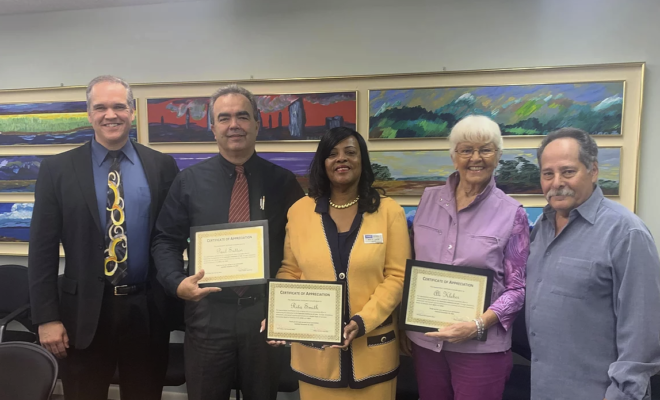
Education
Education Matters | Suncoast Partnership: Working to End Homelessness
By Ryan G. Van Cleave | November 2021
Whether it’s the year-round wonderful weather or the generosity of our neighbors, we see quite a few homeless citizens in our community. According to Endhomelessness.org, 600,000 people were experiencing homelessness in the US in January 2020. 70% were individuals, while the rest were part of families—often with children. Yet what’s the truth? Do we have more homeless citizens in our area than do other cities in Florida, or other places in the country?
According to Chris Johnson, the CEO of the Suncoast Partnership to End Homelessness, the misconception of there being a large local homeless population comes from how we drive down certain streets and notice what seems to be a lot of homeless citizens there. People naturally assume other areas are equally populated with those experiencing homelessness, too. “Those are the most visible, and are usually those that are the most chronically homeless. They often have severe mental health or substance abuse issues,” Johnson says about this visible population that accounts for about 11% of the area’s homeless.
The vast majority of homeless citizens in our area find shelter via the many amazing service provides who partner with Suncoast Partnership, he explains, adding that if we look at the numbers of those who were in shelters from 2016 to 2021, we’ve had a reduction of 44%. That’s not because we’re losing our ability to help, but rather that the need is becoming smaller. Johnson says, “There are 609 fewer homeless people in our community now than those identified as homeless in 2016. Things are definitely trending in a good direction.”
Suncoast Partnership would know because they’re the lead agency for the continuum of care in Sarasota and Manatee counties. Johnson explains, “we are the collaborative applicant for federal funding. So, whenever HUD releases funds that come into communities across the entire nation, we submit that application on behalf of Sarasota and Manatee Counties. We’re the recipient of state funding as well. And we pass that funding to local service providers by subcontracting homelessness service providers such as the Salvation Army, Jewish Family & Children’s Services, and St. Vincent de Paul, as well as other agencies and organizations.”
Johnson has been with Suncoast Partnership for two years, and it suits him well in part because he has a master’s degree in divinity and was a pastor in Texas for nearly 10 years. When he and his wife first came to Sarasota, Johnson applied to the Salvation Army. They told him that “we can teach you about homelessness, and we can teach you about addiction and recovery, but we can’t give you the heart to serve people. That’s something you have to have naturally.” Johnson already had that commitment, and he came in wanting to see people succeed, get well, and receive help. The more he worked at the Salvation Army, the more he began to see the possibilities for helping the homeless population.
“Despite the trauma they’ve faced, many have hope and work their way out of a seemingly hopeless situation,” Johnson notes. “Lives can be transformed in a relatively short amount of time. I mean, seeing the people that came into the recovery programs when I was at the Salvation Army and then later seeing them clean, sober, and working? And they found a place to stay? Our clients’ resiliency is just so amazing.”
Johnson points out that this only happens when a community comes together and says: “You know what? We’re going to take care of those who are the least fortunate. We’re going to take care of those who right now can’t do it by themselves. We’re going to give some help. And we’re going to be here and not give up on people.” That’s how real change happens. And with Suncoast Partnership here to help coordinate and connect all of the agencies and entities into a seamless system as well as identify areas of improvement, we’re on a clear path forward to help transform even more lives.
One thing Johnson recommends, however, is to avoid toxic charity. It’s hard to do this since we’re such a generous giving community. But when somebody asks for money on the streets, if they get money, food, or clothes—essentially having their needs met—they won’t move from that corner. “All of their needs can be met if they connect to the system. The Salvation Army itself has a free dinner every night—there’s no cost, there’s no limit. We have agencies that offer food, shower, cooling, and all the basic needs, including shelter.” And while some of those shelters are temporary, many are pathways to a safe, stable, permanent housing situation.
Those who don’t see the difference between working within the system and letting homeless citizens be on their own need to understand this statistic. The average life expectancy in Sarasota County is 81.2 years. People living on the street die 29.9 years sooner. “People need to understand that every time they hand over a few dollars on the corner,” Johnson explains, “they’re extending one more day of homelessness for that person, which is taking years off of their life.” In short, giving on the street is a one-off, and it’s ultimately more detrimental than good, despite the spirit of helping in which it was given.
“We want to prevent homelessness,” Johnson says. “But if someone experiences it, we want it to be rare, brief, and one time only. That’s our #1 goal.”
FOR MORE INFORMATION about the Suncoast Partnership, please visit www.suncoastpartnership.org or call 941.955.8987.




You must be logged in to post a comment Login